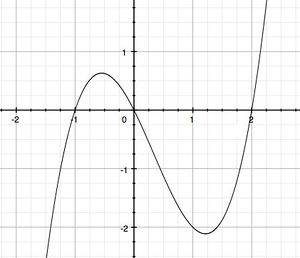Science:Math Exam Resources/Courses/MATH102/December 2011/Question 02 (b) i
{{#incat:MER QGQ flag|{{#incat:MER QGH flag|{{#incat:MER QGS flag|}}}}}}
• Q1 (a) i • Q1 (a) ii • Q1 (b) i • Q1 (b) ii • Q1 (b) iii • Q1 (c) • Q2 (a) i • Q2 (a) ii • Q2 (a) iii • Q2 (b) i • Q2 (b) ii • Q2 (b) iii • Q2 (c) • Q3 • Q4 (i) • Q4 (ii) • Q4 (iii) • Q4 (iv) • Q4 (v) • Q4 (vi) • Q5 • Q6 • Q7 (i) • Q7 (ii) • Q7 (iii) • Q8 (i) • Q8 (ii) • Q8 (iii) • Q9 •
Question 02 (b) i |
|---|
|
Consider the differential equation Find for y(0) = 1. Hint: A sketch of the polynomial may be helpful. |
|
Make sure you understand the problem fully: What is the question asking you to do? Are there specific conditions or constraints that you should take note of? How will you know if your answer is correct from your work only? Can you rephrase the question in your own words in a way that makes sense to you? |
|
If you are stuck, check the hints below. Read the first one and consider it for a while. Does it give you a new idea on how to approach the problem? If so, try it! If after a while you are still stuck, go for the next hint. |
Hint 1 |
|---|
|
Is increasing or decreasing when ? Using the graph of vs. as the hint in the problem suggests, how can you predict the behaviour of as time passes? |
Hint 2 |
|---|
|
What do the zeros of represent? |
|
Checking a solution serves two purposes: helping you if, after having used all the hints, you still are stuck on the problem; or if you have solved the problem and would like to check your work.
|
{{#incat:MER CT flag||
}}














